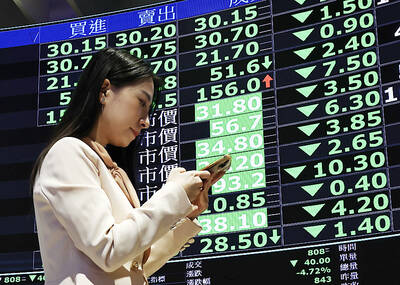JPMorgan Securities Ltd does not think the initial launch of the iPhone 6, if Apple Inc introduces it this fall, will have sapphire crystal for its main display in any significant volume.
With the limited disclosure about the iPhone 6 by Apple and amid persistent speculation about the new phone’s cover glass adoption, JPMorgan believes the volume will be about 10 million covers this year in either 4.7-inch or a 5.5-inch models, according to the brokerage’s latest industry report, released on Tuesday.
That volume of sapphire cover adoption represents less than 1 percent of the entire smartphone market, JPMorgan said.
“Sapphire covers will also be restricted to high-end iPhones, possibly the 128GB [gigabyte] ones,” the brokerage said in the report.
However, the report, authored by analysts Narci Chang (張恆), J.J. Park and Jay Kwon, expects the adoption to rise severalfold next year.
“We believe this will mark only the beginning of sapphire smartphone cover adoption,” they wrote.
Speculation has arisen recently that sapphire crystal might become an alternative to Corning Inc’s damage-resistant Gorilla glass as smartphone cover material, and analysts say other brands, including HTC Corp (宏達電), Asustek Computer Inc (華碩) and Xiaomi Corp (小米), have shown interest in sapphire covers.
However, US-based Corning has responded by saying that sapphire covers for high-end watches are two or three times thicker than Gorilla glass, and that laboratory strength tests have shown sapphire breaks more easily than Gorilla glass.
JPMorgan said sapphire’s cost is also an issue in view of the low yield rates sapphire manufacturers are facing.
“Due to various challenges related to the new cover material, we believe the production output for sapphire covers will be low,” JPMorgan analysts said. “Sapphire ingot yield rates could be as low as below 50 percent for this size, and finished sapphire smartphone covers may cost as much as US$40 to US$45 versus below US$10 for finished Gorilla glass.”
Based on the brokerage’s recent checks with the sapphire supply chain — including GT Advanced Technologies Inc, headquartered in the US, South Korea’s Sapphire Technology Co (STC) and Procrystal Technology Co (佳晶) of Taiwan, JPMorgan said Apple’s iWatches may not all be equipped with sapphire covers.

TARIFFS: The global ‘panic atmosphere remains strong,’ and foreign investors have continued to sell their holdings since the start of the year, the Ministry of Finance said The government yesterday authorized the activation of its NT$500 billion (US$15.15 billion) National Stabilization Fund (NSF) to prop up the local stock market after two days of sharp falls in reaction to US President Donald Trump’s new import tariffs. The Ministry of Finance said in a statement after the market close that the steering committee of the fund had been given the go-ahead to intervene in the market to bolster Taiwanese shares in a time of crisis. The fund has been authorized to use its assets “to carry out market stabilization tasks as appropriate to maintain the stability of Taiwan’s

STEEP DECLINE: Yesterday’s drop was the third-steepest in its history, the steepest being Monday’s drop in the wake of the tariff announcement on Wednesday last week Taiwanese stocks continued their heavy sell-off yesterday, as concerns over US tariffs and unwinding of leveraged bets weighed on the market. The benchmark TAIEX plunged 1,068.19 points, or 5.79 percent, to 17,391.76, notching the biggest drop among Asian peers as it hit a 15-month low. The decline came even after the government on late Tuesday authorized the NT$500 billion (US$15.2 billion) National Stabilization Fund (國安基金) to step in to buoy the market amid investors’ worries over tariffs imposed by US President Donald Trump. Yesterday’s decline was the third-steepest in its history, trailing only the declines of 2,065.87 points on Monday and

TAKING STOCK: A Taiwanese cookware firm in Vietnam urged customers to assess inventory or place orders early so shipments can reach the US while tariffs are paused Taiwanese businesses in Vietnam are exploring alternatives after the White House imposed a 46 percent import duty on Vietnamese goods, following US President Donald Trump’s announcement of “reciprocal” tariffs on the US’ trading partners. Lo Shih-liang (羅世良), chairman of Brico Industry Co (裕茂工業), a Taiwanese company that manufactures cast iron cookware and stove components in Vietnam, said that more than 40 percent of his business was tied to the US market, describing the constant US policy shifts as an emotional roller coaster. “I work during the day and stay up all night watching the news. I’ve been following US news until 3am

TARIFF CONCERNS: The chipmaker cited global uncertainty from US tariffs and a weakening economic outlook, but said its Singapore expansion remains on track Vanguard International Semiconductor Corp (世界先進), a foundry service provider specializing in producing power management and display driver chips, yesterday withdrew its full-year revenue projection of moderate growth for this year, as escalating US tariff tensions raised uncertainty and concern about a potential economic recession. The Hsinchu-based chipmaker in February said revenues this year would grow mildly from last year based on improving supply chain inventory levels and market demand. At the time, it also anticipated gradual quarter revenue growth. However, the US’ sweeping tariff policy has upended the industry’s supply chains and weakened economic prospects for the world economy, it said. “Now